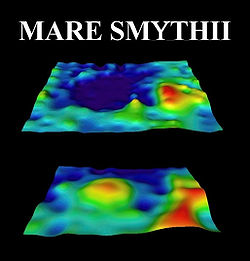
Mare Smythii
Encyclopedia

Lunar mare
The lunar maria are large, dark, basaltic plains on Earth's Moon, formed by ancient volcanic eruptions. They were dubbed maria, Latin for "seas", by early astronomers who mistook them for actual seas. They are less reflective than the "highlands" as a result of their iron-rich compositions, and...
located along the equator on the easternmost edge of the lunar near side. The Smythii basin where the mare is located is of the Pre-Nectarian
Pre-Nectarian
The Pre-Nectarian Period of the lunar geologic timescale runs from 4533 million years ago to 3920 million years ago, when the Nectaris Basin was formed by a large impact. It is followed by the Nectarian period...
epoch
Epoch (geology)
An epoch is a subdivision of the geologic timescale based on rock layering. In order, the higher subdivisions are periods, eras and eons. We are currently living in the Holocene epoch...
, while the surrounding features are of the Nectarian
Nectarian
The Nectarian Period of the lunar geologic timescale runs from 3920 million years ago to 3850 million years ago. It is the period during which the Nectaris Basin and other major basins were formed by large impact events...
system. The mare material, which make up the floor of the mare, is a high aluminous basalt
Basalt
Basalt is a common extrusive volcanic rock. It is usually grey to black and fine-grained due to rapid cooling of lava at the surface of a planet. It may be porphyritic containing larger crystals in a fine matrix, or vesicular, or frothy scoria. Unweathered basalt is black or grey...
, and consists of Upper Imbrian
Upper Imbrian
In the Lunar geologic timescale, the Late Imbrian epoch occurred between 3800 million years ago to about 3200 million years ago. It was the epoch during which the mantle below the lunar basins partially melted and filled them with basalt...
basalt covered by Eratosthenian
Eratosthenian
The Eratosthenian period in the lunar geologic timescale runs from 3,200 million years ago to 1,100 million years ago. It is named after the crater Eratosthenes, whose formation marks the beginning of this period. The formation of the crater Copernicus marks its end, and the beginning of the...
basalt.
The crater Neper
Neper (crater)
Neper is an old lunar impact crater located near the eastern limb of the Moon. Due to its location the crater must be viewed during a suitable libration, and is very foreshortened. The crater lies on the south edge of Mare Marginis, to the east of the crater Jansky...
is located to the north of the mare. This crater makes up part of the southern rim of Mare Marginis
Mare Marginis
Mare Marginis is a lunar mare that lies on the very edge of the lunar nearside. The selenographic coordinates of this feature are 13.3° N, 86.1° E, and the diameter is 420 km. The name is Latin for "Sea of the Edge"....
. Just off to the northwest of the mare are the craters Schubert
Schubert (lunar crater)
Schubert is a lunar impact crater that lies near the eastern limb of the Moon's near side. The crater is located to the northwest of the Mare Smythii, and southwest of the prominent crater Neper...
and Schubert B. The dark mare-filled crater at the southern edge of Smythii is the crater Kästner
Kästner (crater)
Kästner is a lunar crater that is located near the eastern limb of the Moon, to the southwest of the Mare Smythii. Just to the northwest of Kästner is the walled plain Gilbert. To the south is the prominent crater Ansgarius, and to the southwest lies La Pérouse.This formation belongs to the...
.
The Mare Smythii is named for the 19th century British astronomer William Henry Smyth
William Henry Smyth
William Henry Smyth was an English sailor, hydrographer, astronomer and numismatist.-Private Life:...
.

